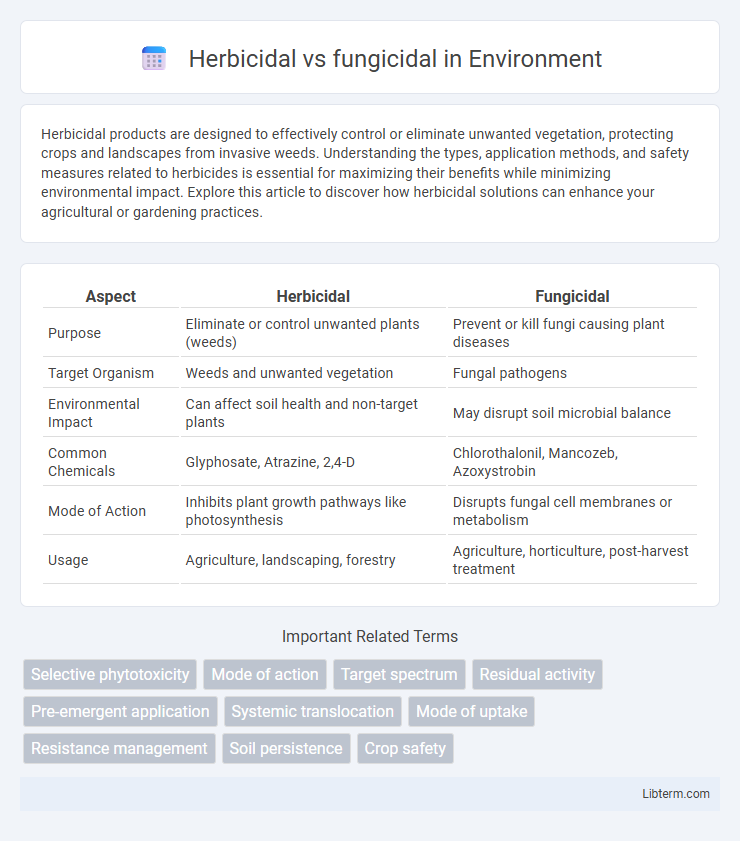Herbicidal products are designed to effectively control or eliminate unwanted vegetation, protecting crops and landscapes from invasive weeds. Understanding the types, application methods, and safety measures related to herbicides is essential for maximizing their benefits while minimizing environmental impact. Explore this article to discover how herbicidal solutions can enhance your agricultural or gardening practices.
Table of Comparison
| Aspect | Herbicidal | Fungicidal |
|---|---|---|
| Purpose | Eliminate or control unwanted plants (weeds) | Prevent or kill fungi causing plant diseases |
| Target Organism | Weeds and unwanted vegetation | Fungal pathogens |
| Environmental Impact | Can affect soil health and non-target plants | May disrupt soil microbial balance |
| Common Chemicals | Glyphosate, Atrazine, 2,4-D | Chlorothalonil, Mancozeb, Azoxystrobin |
| Mode of Action | Inhibits plant growth pathways like photosynthesis | Disrupts fungal cell membranes or metabolism |
| Usage | Agriculture, landscaping, forestry | Agriculture, horticulture, post-harvest treatment |
Understanding Herbicides and Fungicides
Herbicides are chemicals designed to control or eliminate unwanted plants, targeting specific physiological processes in weeds to protect crops and improve agricultural yield. Fungicides, on the other hand, are substances used to prevent or eliminate fungal infections in plants, safeguarding against diseases like powdery mildew, rust, and blight. Understanding the mode of action and application timing of herbicides versus fungicides is crucial for effective pest management and sustainable crop production.
Key Differences Between Herbicides and Fungicides
Herbicides target unwanted plants by disrupting their growth processes, primarily affecting photosynthesis or nutrient absorption, while fungicides specifically inhibit fungal growth by interfering with cell membrane synthesis or reproduction cycles. Herbicides are used to control weeds in crops and lawns, whereas fungicides protect plants from diseases caused by fungi, including powdery mildew and rust. The chemical composition and mode of action distinguish herbicides as plant-specific toxins, whereas fungicides are designed to disrupt fungal biochemistry without harming the host plant.
How Herbicides Work: Targeting Weeds
Herbicides work by disrupting essential physiological processes in weeds, such as photosynthesis, amino acid synthesis, or cell division, effectively inhibiting their growth and survival. Common modes of action include inhibition of acetolactate synthase (ALS), photosystem II blocking, and disruption of lipid synthesis. Herbicides selectively target broadleaf weeds or grasses, ensuring crops remain unharmed while reducing competition for nutrients, water, and sunlight.
Mechanisms of Fungicides: Controlling Fungal Diseases
Fungicides control fungal diseases by targeting critical biological processes such as inhibiting cell membrane synthesis, disrupting energy production, or blocking spore germination. Common mechanisms involve interference with ergosterol biosynthesis, which compromises fungal cell membrane integrity, or inhibition of mitochondrial respiration, leading to energy depletion in fungal cells. These targeted actions effectively suppress fungal growth and prevent the spread of diseases in crops, distinguishing fungicides from herbicides that primarily disrupt plant-specific physiological pathways.
Common Types of Herbicides and Their Uses
Common types of herbicides include selective herbicides like 2,4-D and dicamba, which target broadleaf weeds without harming grasses, making them ideal for lawn and crop protection. Non-selective herbicides such as glyphosate are used for clearing all vegetation, effective in agriculture and industrial weed management. Pre-emergent herbicides like trifluralin prevent weed seed germination, ensuring early-season weed control in crop fields and gardens.
Popular Fungicides and Their Applications
Popular fungicides such as azoxystrobin, chlorothalonil, and copper-based compounds effectively control fungal diseases like powdery mildew, rust, and blight in crops. These fungicides are widely used in agriculture for fruits, vegetables, and cereals to protect plant health and improve yield quality by targeting fungal pathogens on leaves, stems, and roots. Their application timing, concentration, and method, such as foliar sprays or soil treatments, are critical factors influencing efficacy and minimizing resistance development.
Benefits and Risks of Herbicidal Treatments
Herbicidal treatments effectively control unwanted plant species, enhancing crop yield and reducing labor costs by minimizing manual weeding. However, excessive or improper herbicide use can lead to environmental contamination, development of herbicide-resistant weeds, and potential harm to non-target plants and soil health. Balancing herbicidal benefits with sustainable practices is crucial to safeguard ecosystems while maintaining agricultural productivity.
Advantages and Limitations of Fungicidal Approaches
Fungicidal approaches provide targeted control of fungal pathogens, reducing crop losses and improving yield quality by inhibiting or killing harmful fungi without affecting plants. Their advantages include specificity, safety for non-target organisms, and potential for resistance management through diverse modes of action. Limitations involve the development of fungal resistance, environmental persistence concerns, and the necessity for precise application timing to maximize efficacy.
Environmental Impact: Herbicides vs Fungicides
Herbicidal compounds often lead to soil nutrient depletion and diminished biodiversity due to their broad-spectrum activity targeting plant life, whereas fungicides primarily affect fungal communities, potentially disrupting soil microbial balance and nutrient cycling. Persistent herbicides can accumulate in water bodies, causing contamination and harm to aquatic ecosystems, while fungicides may induce resistance in fungal populations and affect non-target organisms, such as beneficial mycorrhizal fungi. Evaluating the differential environmental persistence and toxicity profiles of herbicides and fungicides is crucial for sustainable agricultural practices and minimizing ecological damage.
Choosing the Right Solution: Factors to Consider
Choosing the right solution between herbicidal and fungicidal treatments depends on the specific pest problem, plant type, and environmental conditions. Herbicides target unwanted weeds by disrupting plant growth processes, while fungicides combat fungal infections by inhibiting spore germination or mycelium development. Factors such as crop sensitivity, application timing, resistance management, and local regulations must be carefully evaluated to ensure effective and safe pest control.
Herbicidal Infographic

 libterm.com
libterm.com